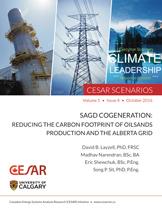To reduce greenhouse gas (GHG) emissions and address the serious challenge of climate change, governments around the world are using a range of policy options. The Alberta government’s policy includes phasing out coal-fired power, significantly increasing renewables in the electrical grid, implementing an economy-wide carbon levy, and putting a limit on annual GHG emissions from the oil sands industry.
This study shows how, over the next 14 years, the existing and planned SAGD operations in Alberta could use off-the-shelf technology to achieve the early retirement of coal from the electrical grid, make space for 12 TWh of new renewable generation, stabilize electricity prices and reduce GHG emissions by 170 Mt CO2. If assigned to oil sands production, these emission reductions would reduce the GHG foot print of SAGD production to less than, or equivalent to, conventional oil.
Read online
Cite this document
Layzell DB, Narendran M, Shewchuk E, Sit SP. 2016. SAGD Cogeneration: Reducing the carbon footprint of oilsands production and the Alberta grid. CESAR Scenarios Vol. 1, Issue 4: 1-37.

